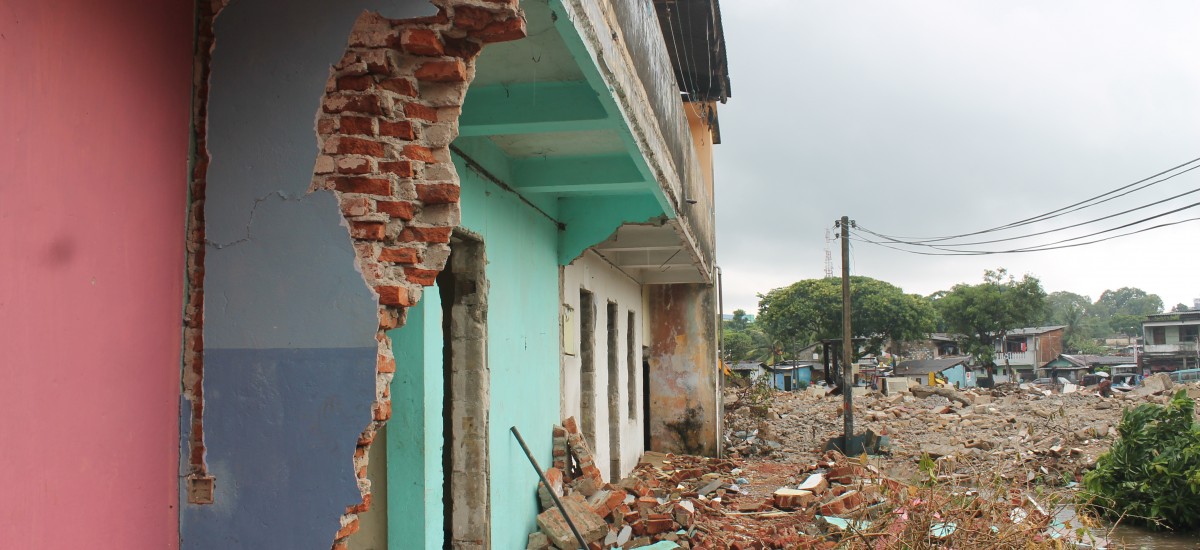Photo courtesy Maatram
I was sitting at my desk in Colombo 08 yesterday and all of a sudden, a somewhat loud but also muffled ‘boom’ broke the usual afternoon sounds of traffic on the road to Parliament.
My first thought was a memory from December 2006, a much louder BOOM from two blocks away that marked the assassination attempt in Kollupitiya on the defence secretary by the LTTE. That boom was the loudest single noise I’d ever heard and was followed by a stunning sort of utter silence – the birds went quiet, there were no voices and even the cars seemed to have cut their engines. All life seemed to hang as if in the air, waiting to fall to earth. Then all hell broke lose, gunshots, sirens, and people started to walk towards the carnage to see what had happened. For years the wall in front of a house at the junction bore the pockmarked imprint of flying debris, a wall that should have been preserved as a sort of historical monument, a reminder of that day and age.
For this reason, my immediate feeling was of slight unease. What was the Borella boom? a bomb(er)? a breaking of the sound barrier (perhaps by a new friend or an old enemy)? But then there was another about five minutes later, then a pause, and within an hour or so a series of, yes it was, blasts. I wondered if other people were similarly reacting by having old memories pop into the brain.
By this time I was reminded of the pile driving for a high-rise I’d experienced not long ago from a block away in Thunmulla Junction, which shook the house and made the small glass pieces of a kitschy overhead light fixture clang against each other. Something related to construction, no doubt; in this day and age the sounds of construction had replaced bombs, but certainly not in a guaranteed sort of way.
It was only hours later that news of the destruction at 34 watte in Wanathamulla, Borella, reached me, and then some photos. There stood the standard replacement high-rise, a model that can be seen all over the world, a perfect example of the ‘one-size-fits-all’ solution to the problem of the urban poor, no matter the climate or culture. Not to their problems but to the problem of their presence. In front was a level ground strewn with various demolition debris, no doubt carrying decades of historical pieces among it. Who had painted that wall green, that one orange? yellow? When had that happened? Where were those families now? Where would the current owners of the debris go to live?
As the development of Colombo steams ahead, the expert answer to such questions is really no different to the answer provided during, say, the development of New York City northwards from lower Manhattan from the 17th century onwards, and until today when a house is not even worth the original mortgaged amount: Who cares? Money talks, money decides, money knows the one best answer, and money does not care about anything else. That is the mindset behind the quick and crude processes at work, and the actual doers are merely automated implementers.
One day it is one particular watte, another it is an old historic building made by a demonised coloniser, one day it is the wrong kind of tree, and another the right sort of sports ground. One day it is the too right sort of house owned by the wrong sort of person, another the wrong sort of house owned by the wrong sort of person. One day it is a tree that shades the wrong sort of people, and another the planting of a tree to shade the right sort. One day the grass is torn up for a car park, and another it is planted again for a nice lawn.
One day another war wall comes down, and another the wall of silent fear gains another brick. Bang, bang, boom, boom … but it is never really silent, you can see it on people’s faces, hear it in a bold remark dropped in a kade, see the eyes roll, see the brains working, see the commonality … the sounds of silence are everywhere.
###
“The Sounds of Silence” is, of course, the title of a song by Simon and Garfunkel.

